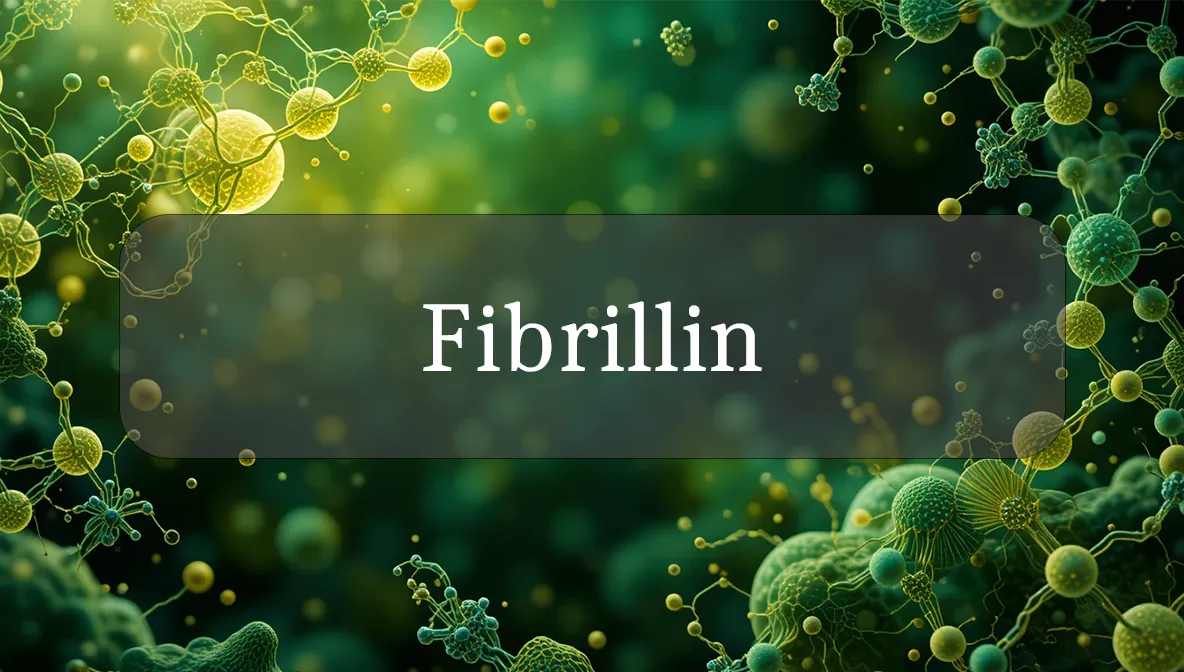Protein That Supports Your Body’s Elastic Framework
Fibrillin is a lesser-known but crucial protein that acts like the scaffolding for your body’s stretchy tissues, helping everything from your skin to your blood vessels stay strong and flexible. It’s a key player in maintaining your body’s structure and resilience, making it essential for daily wellness. Let’s explore what fibrillin is, how it benefits your health, and practical ways to support it—all in a clear, friendly way to empower your health choices.
Identity and Type
Fibrillin is a structural protein and an essential protein, meaning your body produces it from amino acids in your diet, not something you consume directly. It’s a large glycoprotein (a protein with sugar molecules attached) that forms microfibrils—tiny, thread-like structures that provide a scaffold for elastin, the protein that gives tissues their stretchiness. The main types are fibrillin-1, fibrillin-2, and fibrillin-3, with fibrillin-1 being the most critical for connective tissues like skin, blood vessels, and ligaments.
Biological Role and Health Benefits
Fibrillin is like the backbone of your body’s elastic tissues, working closely with elastin to keep you flexible and strong. Here’s how it supports your wellness:
- Tissue Strength and Flexibility: Fibrillin microfibrils form a framework that supports elastin, allowing tissues like skin, lungs, and blood vessels to stretch and recoil.
- Connective Tissue Health: It strengthens ligaments, tendons, and the extracellular matrix (the “glue” between cells), supporting joints and mobility.
- Blood Vessel Integrity: Fibrillin helps arteries stay flexible and durable, promoting healthy blood flow and heart health.
- Eye and Bone Health: It supports the structure of the eye’s lens and contributes to bone strength.
- Growth Factor Regulation: Fibrillin helps control growth signals in tissues, aiding repair and maintenance.
By supporting these systems, fibrillin keeps you moving, resilient, and vibrant.
Dietary Sources and Supplements
Since fibrillin is made by your body, you don’t consume it directly. Instead, you need a diet rich in amino acids and nutrients to support its production. Top sources include:
- Lean Meats: Chicken, turkey, beef, and organ meats like liver (rich in glycine and proline).
- Fish and Seafood: Salmon, mackerel, and shrimp (also provide zinc and copper).
- Eggs: Egg whites are high in amino acids for protein synthesis.
- Dairy: Milk, yogurt, and cheese supply protein and calcium.
- Plant-Based Proteins: Lentils, chickpeas, quinoa, and seeds (pair with vitamin C-rich foods).
- Nutrient Boosters: Vitamin C (oranges, bell peppers, strawberries), copper (shellfish, nuts, whole grains), and zinc (pumpkin seeds, beans) are vital for fibrillin synthesis.
Supplements like collagen peptides or bone broth may indirectly support fibrillin by providing similar amino acids. Aim for 0.8–1.2 grams of protein per kilogram of body weight daily (e.g., 56–84 grams for a 150-pound person).
Signs of Imbalance
Fibrillin “imbalance” refers to reduced production or dysfunction, often due to aging, poor nutrition, or genetic conditions. Signs may include:
- Sagging Skin: Loss of skin firmness or elasticity.
- Joint Instability: Weak ligaments or frequent joint pain.
- Vascular Issues: Weak or overly flexible blood vessels, potentially affecting blood pressure.
- Vision Problems: Lens dislocation or eye issues (linked to rare disorders like Marfan syndrome).
- Slow Tissue Repair: Delayed healing of connective tissues after injury.
These signs may stem from lifestyle factors or rare genetic conditions affecting fibrillin, like Marfan syndrome or congenital contractural arachnodactyly.
Supporting Optimal Levels or Function
To keep fibrillin healthy and maintain its benefits, try these practical steps:
- Eat Protein-Rich Foods: Include protein in every meal to provide amino acids for fibrillin production (e.g., eggs for breakfast, chicken for lunch, beans for dinner).
- Boost Key Nutrients: Eat vitamin C-rich foods (citrus, leafy greens) and copper/zinc sources (nuts, shellfish) to support fibrillin synthesis.
- Protect Connective Tissues: Avoid smoking and limit sun exposure (use SPF 30+) to prevent fibrillin breakdown.
- Exercise Moderately: Activities like yoga, walking, or light strength training support connective tissue health without overstraining.
- Stay Hydrated: Drink 8–10 cups of water daily to keep tissues supple and support fibrillin’s role.
- Get Enough Sleep: Sleep (7–9 hours) promotes tissue repair and protein synthesis.
- Consider Collagen Support: Collagen supplements (5–10 grams daily) may indirectly aid fibrillin by supporting connective tissue health.
Safety, Interactions, and Precautions
Fibrillin is naturally produced and safe, but consider these points:
- Lifestyle Risks: Smoking, excessive UV exposure, or poor diet can degrade fibrillin faster than your body can rebuild it.
- Supplements: Collagen or amino acid supplements are generally safe but may cause mild digestive upset in high doses (above 15 grams daily).
- Allergies: Supplements from fish or shellfish may trigger allergies in sensitive individuals.
- Genetic Conditions: Disorders like Marfan syndrome, caused by fibrillin-1 gene mutations, require medical management. If you have a family history of connective tissue issues, consult a doctor.
- Overuse Injuries: Excessive intense exercise can strain connective tissues, so balance activity with rest.
Fun Fact
Did you know fibrillin is so tough that it helps your aorta—the body’s largest artery—withstand the pressure of every heartbeat for your entire life? This incredible protein is like a silent superhero keeping your blood flowing smoothly!
Citations
- National Institutes of Health. (2023). Connective tissue health and proteins. MedlinePlus.
- Mayo Clinic. (2024). Nutrition for skin and tissue health.
- Cleveland Clinic. (2022). The role of proteins in connective tissue function.
- World Health Organization. (2020). Protein and amino acid requirements in human nutrition.
- USDA FoodData Central. (2023). Nutrient profiles for protein-rich foods.

